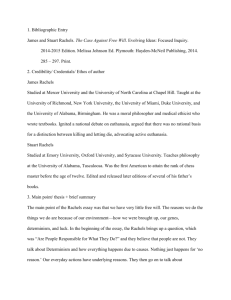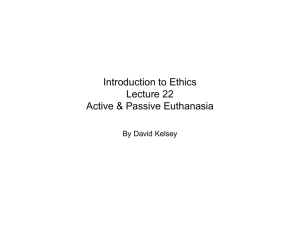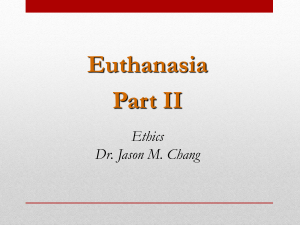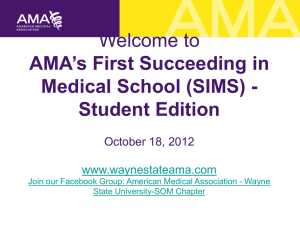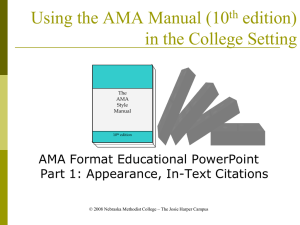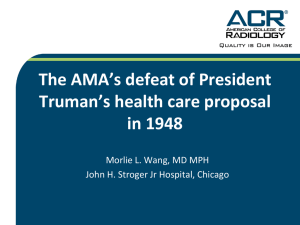Active and Passive Euthanasia: An Impertinent Distinction
advertisement
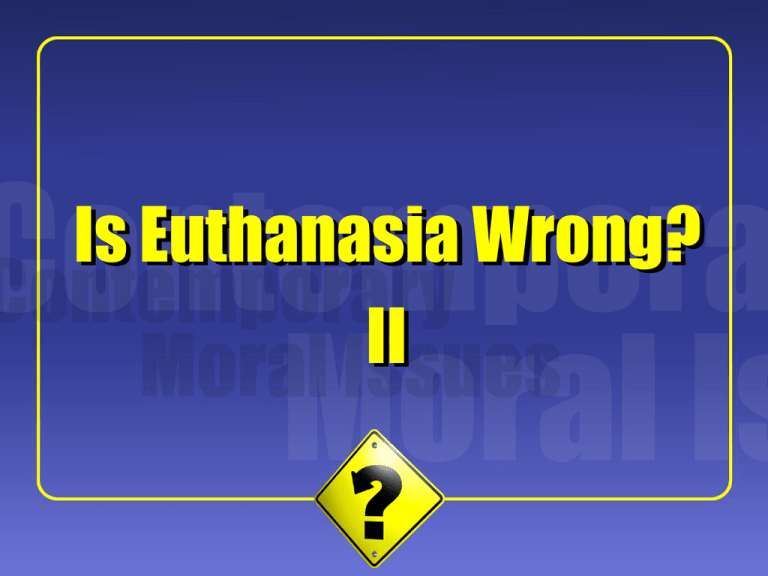
1 Is Euthanasia Wrong? II 2 Thomas D. Sullivan: “Active and Passive Euthanasia: An Impertinent Distinction ” Sullivan’s Project • Sullivan argues that Rachels misinterprets the AMA doctrine, and that, when read correctly, the doctrine does not lead to the problems that Rachels contends. 3 American Medical Association Doctrine: The intentional termination of the life of one human being by another—mercy killing—is contrary to that for which the medical profession stands and is contrary to the policy of the American Medical Association. The cessation of the employment of extraordinary means to prolong the life of the body when there is irrefutable evidence that biological death is imminent is the decision of the patient and/or his immediate family. The advice and judgment of the physician should be freely available to the patient and/or his immediate family. • The AMA doctrine forbids “active euthanasia”, and permits “passive euthanasia”. 4 Recall Rachels’ Arguments: • Rachels presents three arguments against the policy: i. The AMA policy is cruel. Case 1: Throat Cancer Patient: The AMA policy seems to require that such a patient endure a slow, painful death rather than allowing a lethal injection for terminally-ill patients. 5 Recall Rachels’ Arguments: ii. The AMA policy leads to life-and-death decisions based on irrelevant grounds. Case 2: Down’s Syndrome Baby: The AMA policy, strictly interpreted, seems to allow newborn Down’s syndrome babies to die from intestinal blockages, though this is not the reason that parents think it best to let the babies die. 6 Recall Rachels’ Arguments: iii. The distinction made by the AMA policy is based on a false assumption that killing is worse than letting die. Smith & Jones Thought Experiment: If killing were worse than letting die, we should say that Jones’ behavior was less reprehensible than Smith’s. But we do not want to say this, so this basis for the AMA doctrine is untenable. 7 Points of Agreement Sullivan agrees with Rachels that: 1) Letting a Down’s syndrome baby die from starvation and dehydration is cruel. “It is cruel to stand by and watch a Down’s syndrome baby die an agonizing death when a simple operation would remove the intestinal obstruction, but to offer the excuse that in failing to operate we didn’t do anything to bring about the death is an example of moral evasiveness comparable to the excuse Jones would offer for his action of “merely” letting his cousin die.” (197) 8 Points of Agreement Sullivan agrees with Rachels that: 2) There is no extra-moral badness that necessarily comes along with killing that wouldn’t come along with letting die. “[I]t is true that if someone is trying to bring about the death of another human being, then it makes little difference from a moral point of view if his purpose is achieved by action or by malevolent omission, as in the cases of Jones and Smith.” (197) 9 Sullivan’s Criticisms of Rachels Sullivan argues, contrary to Rachels’ contention, that AMA policy is not based on an untenable moral distinction between killing and letting die. • According to the AMA policy (charitably interpreted) intentionally killing a patient is wrong. ► Intentionally killing a patient “can be done by acting to bring about [his] death or by refusing ordinary means to keep [him] alive in order to bring about the same goal.” (197) 10 Sullivan’s Criticisms of Rachels • What the AMA policy permits is refraining from employing extraordinary means to prolong life (under some conditions). ► The AMA policy makes no mention of ordinary means. ► Recall last class, slide 5: The North Carolina legal definition of “extraordinary means” includes “any procedure or intervention which in the judgment of the attending physician would serve only to postpone artificially the moment of death.” ► Sullivan refers to a definition of “extraordinary means” from Paul Ramsey’s book, The Patient as Person: “Extra-ordinary means of preserving life are all those medicines, treatments, and operations which cannot be obtained without excessive expense, pain, or other inconvenience, or which, if used, would not offer a reasonable hope of benefit.” (197) 11 Sullivan’s Criticisms of Rachels • There is a legitimate distinction to be made between intentionally killing someone and refraining from taking extraordinary means to save the person. ► One can refrain from taking extraordinary means to save someone without at the same time intentionally killing him. ► One can foresee that a certain action will result in the patient’s death without thereby intending the patient’s death! 12 Sullivan’s Criticisms of Rachels ► If I drive downtown, I can foresee that I’ll wear down my tires a little, but I don’t drive downtown with the intention of wearing down my tires. 13 Sullivan’s Criticisms of Rachels ► If I forego my exercises for a few days, I can foresee that my physical condition will deteriorate a little, but I don’t omit my exercise with a view to running myself down. 14 Sullivan’s Criticisms of Rachels If you have to hire someone to fill a job, and you hire Mrs. Green, who is better qualified, rather than Mr. Brown, you can foresee that you will hurt Mr. Brown. But you needn’t hire Mrs. Green with the intention of hurting Mr. Brown. • “[I]t is not the case that all foreseeable consequences and side effects of our conduct are necessarily intended. And it is because the physician’s withdrawal of certain extra-ordinary means can be otherwise motivated than by a desire to bring about the predictable death of the patient that such action cannot categorically be rules out as wrong.” (198) ► It may still be the case that the patient will make a miraculous recovery, and this doesn’t go against the physician’s intentions. ► 15 Ordinary and Extraordinary Means Refusing ordinary means is another matter: what would be the point of refusing assistance which would offer a reasonable hope of benefit without excessive pain or expense? • The AMA position rules out not only direct actions to bring about death (such as lethal injection), but also malevolent omissions, such as not providing ordinary care for a newborn baby. • Rachels ignores the difference between ordinary and extraordinary means: performing surgery on the newborn or saving the drowning boy are certainly not extraordinary measures to take. 16 Conclusion • Since the AMA doctrine does not allow for letting Down’s syndrome babies to die from intestinal blockage, it is neither cruel nor does it lead to life and death decisions being made on irrelevant grounds. • The AMA doctrine does not rest on some distinction between “active” and “passive” euthanasia. • The AMA doctrine does not rest on some distinction between action and omission. • Rather, the AMA doctrine is simply a prohibition against intentional killing, whether by action or omission.
